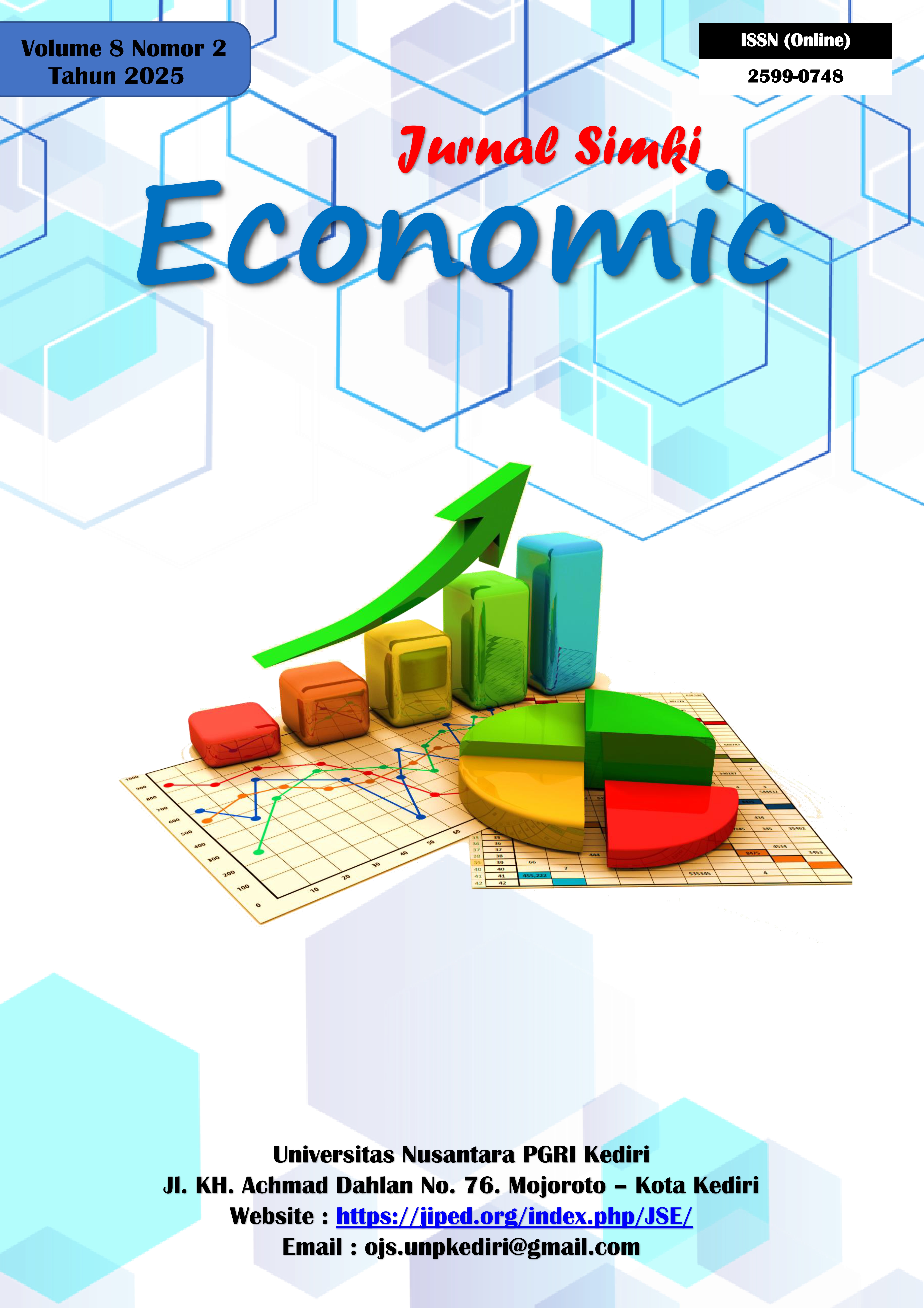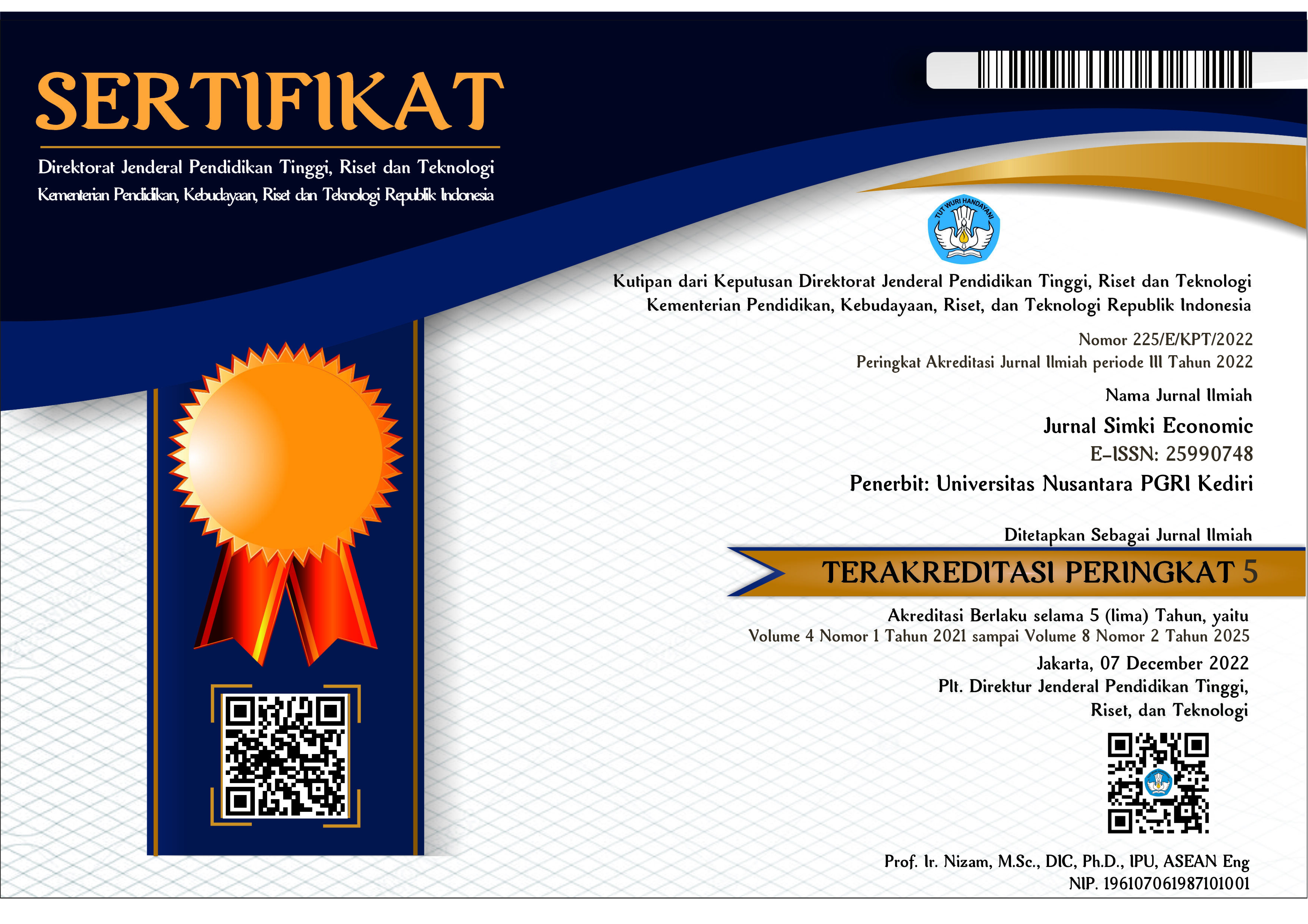Pengaruh Kepemilikan Manajerial dan Kepemilikan Asing terhadap Kinerja Perusahaan di Sektor Perdagangan, Jasa dan Investasi
 Abstract views: 228
,
Abstract views: 228
,
 PDF (Bahasa Indonesia) downloads: 88
PDF (Bahasa Indonesia) downloads: 88
Abstract
This study aims to empirically examine the effect of managerial ownership and foreign ownership on company performance. Secondary data from 208 annual financial reports of companies in the trade, services, and investment sectors for the period 2021–2023 are used as panel data and analyzed using multiple linear regression, with Return on Assets (ROA) as a performance indicator. The results of the study indicate that managerial ownership and foreign ownership have no effect on company performance. Theoretically, these results indicate that ownership structure is not the main factor in driving performance, thus contributing to the development of governance theory in developing countries. Practically, these results serve as a reference for stakeholders to consider other more relevant factors in performance improvement strategies.
Downloads
References
Al-Gamrh, B., Al-Dhamari, R., Jalan, A., & Afshar Jahanshahi, A. (2020). The Impact of Board Independence and Foreign Ownership on Financial and Social Performance of Firms: Evidence From the UAE. Journal of Applied Accounting Research, 21(2), 201–229. https://doi.org/10.1108/JAAR-09-2018-0147
Alfadhl, M. M. A. F., & Alabdullah, T. T. Y. (2013). Determinants of the Managerial Behavior of Agency Cost and its Influential Extent on Performance : A study in Iraq. International Journal of Humanities and Social Science, 3(6), 238–252. https://www.ijhssnet.com/journals/Vol_3_No_7_April_2013/26.pdf
Andrean Agasva, B., & Budiantoro, H. (2020). Pengaruh Good Corporate Governance dan Ukuran Perusahaan terhadap Kinerja Perusahaan (Studi pada Perusahaan Manufaktur yang Terdaftar di BEI Tahun 2014-2017). JEBA (Journal of Economics and Business Aseanomics), 5(1), 33–53. https://doi.org/10.33476/j.e.b.a.v5i1.1403
Anshori, S., Hapsari, D. A., & Giri, E. F. (2023). Pengaruh Kepemilikan Asing, Kepemilikan Manajemen, Kepemilikan Institusional terhadap Kebijakan Dividen yang Dimoderasi oleh Tingkat Leverage. Kompartemen : Jurnal Ilmiah Akuntansi, 21(2), 318. https://doi.org/10.30595/kompartemen.v21i2.17981
BPS. (2020). Analisis Hasil Survei Dampak Pelaku Usaha.
Epi, Y. (2017). Pengaruh Ukuran Perusahaan, Struktur Kepemilikan Manajerial dan Manajemen Laba Terhadap Kinerja Perusahaan Property dan Real Estate. Jurnal Riset Akuntansi, 1(1), 1–7. https://owner.polgan.ac.id/index.php/owner/article/view/8
Jensen, M.C., dan Meckling, W. H. (1976). Theory of the Firm: Managerial Behavior, Agency Costs and Ownership Structure. Journal of Financial Economics, 3, 305–360. https://doi.org/10.1057/9781137341280.0038
Kajirwa, H. I. (2015). A Survey of Commercial Banks Listed on Nairobi Securities Exchange. Global Journal of Advanced Research.
Legina Steisi Pandensolang, R. B. U. (2024). Pengaruh Kepemilikan Manajerial, Institusional, Asing dan Keluarga terhadap Kinerja Keuangan pada Sektor Consumer Cyclicals yang Terdaftar di Bursa Efek Indonesia 2014-2023. Economic Reviews Journal, 3(1), 96–108. https://doi.org/10.56709/mrj.v3i3.590
Maulana, I., Wildan, M. A., & Andriani, N. (2021). Pengaruh Struktur Kepemilikan terhadap Kinerja Perusahaan Dimoderasi oleh Karakteristik Dewan Komisaris. Jurnal Akuntansi, 13, 173–187. https://doi.org/10.28932/jam.v13i1.2934
Nuryaman. (2015). The Influence of Intellectual Capital on the Firm’s Value with the Financial Performance as Intervening Variable. Procedia - Social and Behavioral Sciences, 211(September), 292–298. https://doi.org/10.1016/j.sbspro.2015.11.037
Putri, N. M., & Rivandi, M. (2023). Struktur Modal dan Likuiditas Terhadap Profitabilitas Pada Sektor Perdagangan, Jasa dan Investasi. Co-Value Jurnal Ekonomi Koperasi dan kewirausahaan, 14(7). https://doi.org/10.59188/covalue.v14i7.3937
Rashid, M. M. (2020). “Ownership structure and firm performance: the mediating role of board characteristics.” Corporate Governance: The International Journal of Business in Society, 20(4), 719–737. https://doi.org/10.1108/CG-02-2019-0056
Siprianus, F. L., & Utomo, R. B. (2024). Pengaruh Kepemilikan Manajerial, Kepemilikan Asing,Kepemilikan Institusional dan Kepemilikan Konsentrasi terhadap Kinerja Perusahaan Sub Sektor Rokok yang terdaftar di Bursa Efek Indonesia Periode 2014-2023. Jurnal Riset Ekonomi, 4(3), 651–660. https://bajangjournal.com/index.php/Juremi/article/view/8914
Sugianto, S., & Sjarief, J. (2018). Analisis Pengaruh Kepemilikan Manajerial, Proporsi Dewan Komisaris Independen, Dan Konservatisme Akuntansi Terhadap Kualitas Laba Serta Pengaruhnya Terhadap Nilai Perusahaan. Jurnal Akuntansi, 12(1), 80–103. https://doi.org/10.25170/jara.v12i1.59
Suyono, E. (2016). Family Controlled Firm, Governance Mechanisms and Corporate Performance: Evidence from Indonesia. Journal of Economics, Business & Accountancy Ventura, 19(1), 111. https://doi.org/10.14414/jebav.v19i1.528
Suyono, S., Nanang, A., & Priyatmoko, P. (2024). Pengaruh Pertumbuhan Perusahaan, Kepemilikan Manajerial, Leverage dan Ukuran Perusahaan pada Kinerja Perusahaan Manufaktur di BEI. Jurnal Akuntansi, Manajemen dan Perbankan Syariah, 4(2), 69–80. https://doi.org/10.32699/jamasy.v4i2.6985
Tempo. (2021). Dampak PSBB, Matahari Rugi Rp 873,18 Miliar Sepanjang Tahun 2020. TEMPO.
Tjakrawala, K., & Tjahjadi, H. (2020). Pengaruh Kepemilikan Manajerial, Kepemilikan Publik, dan Kepemilikan Asing terhadap Kinerja Perusahaan. Jurnal Paradigma Akuntansi, 2(2), 736. https://doi.org/10.24912/jpa.v2i2.7655
Copyright (c) 2025 Rindu Kurniawati, Rahman Anshari, Yulia Tri Kusumawati

This work is licensed under a Creative Commons Attribution 4.0 International License.














